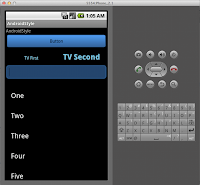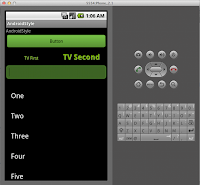Иногда приходится сталкиваться с необходимостью оформления приложения в разном цвете не изменяя расположения и размеров UI элементов.
В этой статье расскажу об использовании тем и стилей в android.
Будет показано как применять стили для Button, EditText, ListView, TextView.
Для начала создадим новый проект и добавим в него два новых activity.
Для одного мы будем применять Theme.Green для второго Theme.Blue.
Я проект назвал AndroidStyle.
Дополнительные activity: BlueThemeActivity, GreenThemeActivity.
Вот так вот выглядит только-что созданный проект:
Не забываем прописать activity в AndroidManifest файле.
<?xml version="1.0" encoding="utf-8"?>
<manifest xmlns:android="http://schemas.android.com/apk/res/android"
package="com.lunevich.androidstyle"
android:versionCode="1"
android:versionName="1.0" >
//...
<application
android:icon="@drawable/ic_launcher"
android:label="@string/app_name" >
//...
<activity android:name=".activity.BlueThemeActivity" ></activity>
<activity android:name=".activity.GreenThemeActivity" ></activity>
</application>
</manifest>
Теперь добавим layout которому мы будем менять тему. Назовем stylish.xml, добавим в него наши UI элементы. Должно получиться что-то такое:
stylish.xml
<?xml version="1.0" encoding="utf-8"?>
<LinearLayout xmlns:android="http://schemas.android.com/apk/res/android"
android:layout_width="fill_parent"
android:layout_height="fill_parent"
android:orientation="vertical" >
<TextView
android:layout_width="fill_parent"
android:layout_height="wrap_content"
android:text="@string/app_name" />
<Button
android:id="@+id/btn"
android:layout_width="fill_parent"
android:layout_height="wrap_content"
android:layout_margin="3dp"
android:text="@string/btn" />
<LinearLayout
android:layout_width="fill_parent"
android:layout_height="wrap_content"
android:layout_marginBottom="10dp"
android:layout_marginTop="10dp"
android:orientation="horizontal" >
<TextView
android:id="@+id/tv1"
style="?attr/textView1"
android:layout_width="fill_parent"
android:layout_height="wrap_content"
android:layout_weight="1"
android:gravity="center"
android:text="@string/tv1"
android:textAppearance="?android:attr/textAppearanceMedium" />
<TextView
android:id="@+id/tv2"
style="?attr/textView2"
android:layout_width="fill_parent"
android:layout_height="wrap_content"
android:layout_weight="1"
android:gravity="center"
android:text="@string/tv2"
android:textAppearance="?android:attr/textAppearanceMedium" />
</LinearLayout>
<EditText
android:id="@+id/editText"
android:layout_width="fill_parent"
android:layout_height="wrap_content"
android:layout_marginBottom="10dp"
android:ems="10"
android:inputType="text" >
<requestFocus />
</EditText>
<ListView
android:id="@+id/listView"
android:layout_width="fill_parent"
android:layout_height="fill_parent" >
</ListView>
</LinearLayout>
Чтобы определить наши style="?attr/..." выделенные жирным шрифтом в stylish.xml нам необходимо добавить файл attrs.xml. Вот такой файл получается:
attrs.xml
<?xml version="1.0" encoding="utf-8"?>
<resources>
<attr name="textView1" format="reference" />
<attr name="textView2" format="reference" />
</resources>
Можно приступить к написанию стилей. Я покажу пример для синего стиля.
В папке res/values/ создадим файл styles.xml и напишем в него наш синий стиль для UI элементов.
Вот такой файл должен получиться:
styles.xml
<?xml version="1.0" encoding="utf-8"?>
<resources>
<!-- =============== -->
<!-- Blue styles -->
<!-- =============== -->
<!-- blue text view style -->
<style name="blue_text_view_1">
<item name="android:textColor">#60c4e4</item>
<item name="android:textSize">14sp</item>
<item name="android:gravity">center_vertical|left</item>
<item name="android:shadowDx">1.0</item>
<item name="android:shadowDy">1.0</item>
<item name="android:shadowRadius">1</item>
<item name="android:shadowColor">#DDD</item>
</style>
<!-- blue text view style -->
<style name="blue_text_view_2">
<item name="android:textColor">#60c4e4</item>
<item name="android:textSize">24sp</item>
<item name="android:textStyle">bold</item>
<item name="android:gravity">center_vertical|left</item>
<item name="android:shadowDx">1.0</item>
<item name="android:shadowDy">1.0</item>
<item name="android:shadowRadius">1</item>
<item name="android:shadowColor">#DDD</item>
</style>
<!-- blue button style -->
<style name="blue_button" parent="@android:style/Widget.Button">
<item name="android:background">@drawable/blue_button</item>
</style>
<!-- blue edit text style -->
<style name="blue_edit_text" parent="@android:style/Widget.EditText">
<item name="android:background">@drawable/blue_edit_text</item>
</style>
<!-- blue edit text style -->
<style name="blue_list_view">
<item name="android:listSelector">@drawable/blue_list_view_item</item>
</style>
</resources>
В нашем стиле используются drawable ресурсы drawable/blue_button.xml, drawable/blue_edit_text.xml, drawable/blue_list_view_item.xml. Для blue_button, blue_edit_text и blue_list_view_item создадим в папке res папку drawable и в ней файл blue_button.xml, blue_edit_text.xml и
blue_list_view_item.xml. Добавим в наши созданные файлы вот такое контент ( он отвечает за внешний вид наших UI элементов ):
blue_button.xml
<?xml version="1.0" encoding="utf-8"?>
<selector xmlns:android="http://schemas.android.com/apk/res/android">
<item android:state_pressed="true">
<shape>
<solid android:color="#449def" />
<stroke android:width="1dp" android:color="#2f6699" />
<corners android:radius="3dp" />
<padding android:bottom="10dp" android:left="10dp" android:right="10dp" android:top="10dp" />
</shape>
</item>
<item>
<shape>
<gradient android:angle="270" android:endColor="#2f6699" android:startColor="#449def" />
<stroke android:width="1dp" android:color="#2f6699" />
<corners android:radius="4dp" />
<padding android:bottom="10dp" android:left="10dp" android:right="10dp" android:top="10dp" />
</shape>
</item>
</selector>
В blue_button.xml прописан внешний вид кнопки в нажатом и не нажатом состоянии.
Атрибут android:state_pressed="true" указывает на то что данный стиль применим для кнопки в нажатом состоянии.
blue_edit_text.xml
<?xml version="1.0" encoding="utf-8"?>
<selector xmlns:android="http://schemas.android.com/apk/res/android">
<item android:state_pressed="true">
<shape>
<gradient android:angle="270" android:centerColor="#603C86C9" android:centerX="0.5" android:centerY="0.5" android:endColor="#9045A0F5" android:startColor="#403270A8" />
<stroke android:width="3dp" android:color="#50449def" />
<corners android:radius="7dp" />
<padding android:bottom="10dp" android:left="10dp" android:right="10dp" android:top="10dp" />
</shape>
</item>
<item>
<shape android:shape="rectangle">
<solid android:color="#20486E" />
<stroke android:width="3dp" android:color="#50449def" />
<corners android:radius="7dp" />
<padding android:bottom="10dp" android:left="10dp" android:right="10dp" android:top="10dp" />
</shape>
</item>
</selector>
В blue_edit_text.xml прописан внешний вид EditText в активном и неактивном состоянии.
Атрибут
android:state_pressed="true" указывает на то, какой стиль будет использоваться когда мы нажмем на EditText для ввода текста.
blue_list_view_item.xml
<?xml version="1.0" encoding="utf-8"?>
<selector xmlns:android="http://schemas.android.com/apk/res/android">
<item android:state_pressed="true">
<shape>
<gradient android:angle="270" android:centerColor="#603C86C9" android:centerX="0.5" android:centerY="0.5" android:endColor="#9045A0F5" android:startColor="#403270A8" />
<stroke android:width="3dp" android:color="#50449def" />
<corners android:radius="7dp" />
<padding android:bottom="10dp" android:left="10dp" android:right="10dp" android:top="10dp" />
</shape>
</item>
<item android:state_focused="true">
<shape android:shape="rectangle">
<solid android:color="#20486E" />
<stroke android:width="3dp" android:color="#50449def" />
<corners android:radius="7dp" />
<padding android:bottom="10dp" android:left="10dp" android:right="10dp" android:top="10dp" />
</shape>
</item>
</selector>
Теперь непосредственно создадим тему для наших стилей. Для этого в папке res/values/ создадим файл themes.xml. И применим в нем для наших атрибутов созданные стили.
themes.xml
<?xml version="1.0" encoding="utf-8"?>
<resources>
<!-- =============== -->
<!-- Blue theme -->
<!-- =============== -->
<style name="Theme.Blue" parent="@android:style/Theme">
<item name="textView1">@style/blue_text_view_1</item>
<item name="textView2">@style/blue_text_view_2</item>
<item name="android:buttonStyle">@style/blue_button</item>
<item name="android:editTextStyle">@style/blue_edit_text</item>
<item name="android:listViewStyle">@style/blue_list_view</item>
</style>
</resources>
textView1 и textView2 наши собственные атрибуты, которые мы создали ранее в attrs.xml.
android:buttonStyle, android:editTextStyle атрибуты по-умолчанию.
Теперь мы сделали все что необходимо для стилей и тем в нашем приложении. Применить созданный стиль мы можем в AndroidManifest файле для выбранного нами activity или же ( как сделал я ) определить стиль непосредственно в activity.
В AndroidManifest.xml это желается вот так:
<?xml version="1.0" encoding="utf-8"?>
<manifest xmlns:android="http://schemas.android.com/apk/res/android"
package="com.lunevich.androidstyle"
android:versionCode="1"
android:versionName="1.0" >
//...
<application
android:icon="@drawable/ic_launcher"
android:label="@string/app_name" >
//...
<activity android:name=".activity.BlueThemeActivity" android:theme="@style/Theme.Blue"></activity>
<activity android:name=".activity.GreenThemeActivity" android:theme="@style/Theme.Green"></activity>
</application>
</manifest>
В activity делается вот так:
package com.lunevich.androidstyle.activity;
import com.lunevich.androidstyle.R;
import android.app.Activity;
import android.os.Bundle;
import android.view.View;
import android.view.View.OnClickListener;
import android.widget.ArrayAdapter;
import android.widget.Button;
import android.widget.ListView;
public class BlueThemeActivity extends Activity implements OnClickListener {
@Override
public void onCreate(Bundle savedInstanceState) {
super.onCreate(savedInstanceState);
setTheme(R.style.Theme_Blue);
setContentView(R.layout.stylish);
String[] items = { "One", "Two", "Three", "Four", "Five" };
ListView listView = (ListView) findViewById(R.id.listView);
listView.setAdapter(new ArrayAdapter<String>(this, android.R.layout.simple_list_item_1, items));
Button btn = (Button) findViewById(R.id.btn);
btn.setOnClickListener(this);
}
@Override
public void onClick(View v) {
switch (v.getId()) {
case R.id.btn:
onBackPressed();
break;
}
}
@Override
public void onBackPressed() {
super.onBackPressed();
this.finish();
}
}
Посмотрим на результаты:
 |
| blue-theme |
 |
| green-theme |
полный код приложения лежит вот тут ->
AndroidStyle
прямая ссылка для скачивания архива ->
Download
Вышло очень даже симпатично :). Спасибо за внимание.
P.S. Оставляем пожелания, комментарии, темы для рассмотрения. И кликаем +1, f, в, t, что располагаются чуть ниже статьи.



